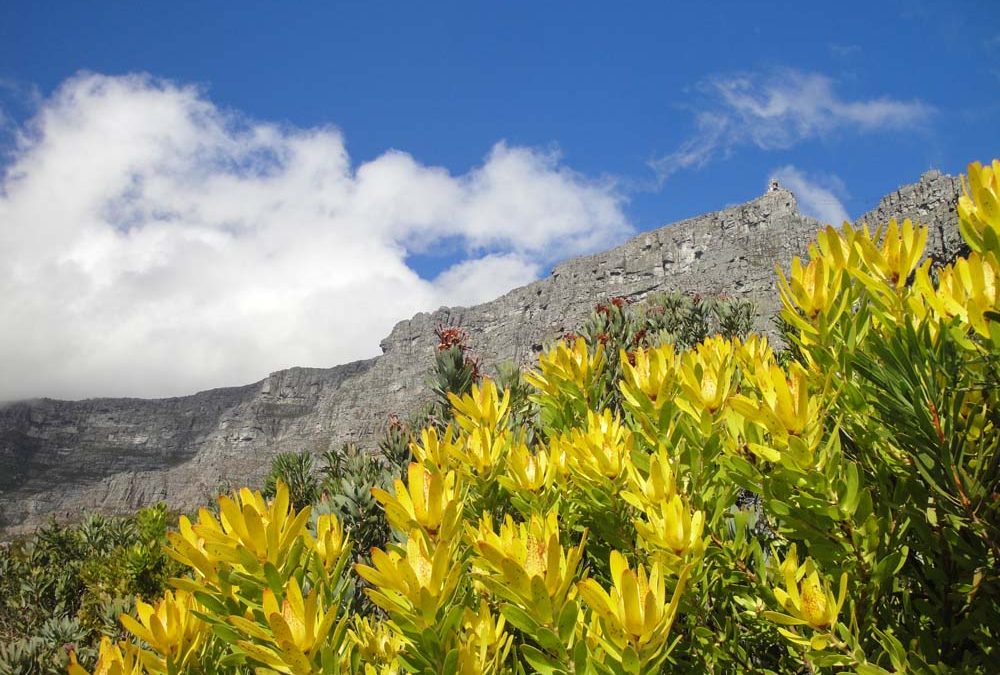If you don’t like the weather, Cape Town residents like to say, simply wait for a couple of hours and you’ll get something different. And although the climate does appear to be somewhat random, the weather in the Mother City actually follows a fairly dependable course throughout the year.
The Cape Town climate mirrors the four seasons of the northern hemisphere except in reverse. December is hot and sunny mid-summer; July is shivery mid-winter. In very general terms however, it is easier to divide the year into two seasons: a warm and mostly dry period from November to April and a cooler and wetter period between May and October.

Cape Town’s summer weather is predictably warm & dry – perfect for hiking.
The dry season is dominated by a wind coming out of the south-east – the Cape Doctor. Present for half of the year, the wind’s healing reputation lies in the fact that it cools down summertime Cape Town and blows the city’s smoke and dust out to sea. The downside is that the Doctor really blows, often ferociously so. Cape Point experiences 100 days of gale force winds a year – that’s strong enough to knock a child off their feet – and Table Mountain’s picturesque Table Cloth is in reality a mass of howling, wind-blown cloud that soaks the Table Top area and forces the cable car to close.

Autumn’s cooler weather brings low-lying fog on some Cape Town mornings.
During the cooler winter months, the wind now comes mostly from the west, and if you remove the letter ‘S’ from the word ‘west’, you have winter’s weather pattern in a nutshell. North-west winds bring bad-tempered Atlantic storms with heavy drenching rain; south-west winds race up from lower and colder latitudes and drop snow on the high ground of the Cape Winelands and Overberg regions. On the Cape Peninsula, the warming effect of an ocean on either side ensures that temperatures never really drop below 10°C/50°F.

Bad weather is often signalled by the presence of high level cirrus clouds forming bands across the sky.
But if you do find yourself looking at a cloud-covered Table Mountain or you are battling to stay on your feet at Cape Point, there may be a solution. The trick is knowing where to go.
If, for example, the Cape Doctor is raging from the south-east at 50 kilometres per hour, you can forget Table Mountain’s Table Top and cable car. But, facing west and protected by towering cliffs, the Pipe Track on the 12 Apostles section of Table Mountain is sheltered and great for an easy hike. And if there is an Atlantic cold front dumping rain all over Cape Town and covering Table Mountain with soggy cloud, chances are it’ll be bright and sunny in the Silvermine mountains twenty minutes away.

Typical summer weather on Table Mountain’s Table Top – clear blue sky, hot sunshine & views for miles.
Travellers planning a holiday or safari in other parts of South Africa should also take note of the fact that the Cape Town climate is also the complete opposite to the rest of the country and greater southern Africa region. Places like the Kruger National Park, Victoria Falls and Botswana are all in the middle of their wet seasons over December and January – the very driest months in Cape Town. And when most of southern Africa lies under the clear blue skies of June, July and August, Cape Town is battered by battleship-grey Atlantic storms. April and May as well as September and October are probably the best months to combine Cape Town with a safari in the Kruger or Botswana – that way you should get decent weather in the Cape with good game viewing in dry conditions further north.

Also typical summer weather on Table Mountain … roaring wind & drenching cloud!
The best time to visit Cape Town for depends of course on what your main interests are. If they are outdoor pursuits such as hiking and bird watching then it’s hard to beat the almost certainty of dry and sunny weather in summer; if you don’t want hot, windy and dry conditions, then try the quieter autumn, winter or spring months and take a chance on the weather. The table below gives you an overview of the Cape Town climate and should help you make a decision about when best to go.
Nov | Dec | Jan | Feb | Mar
Generally warm to hot weather with very little rain; peak windy season, especially Dec – Feb. Peak holiday season over Christmas & New Year – Table Mt & Cape Point very busy. Good for half-day hikes & multi-day hiking.
April | May
Autumn brings cooler weather & the first rains, usually as light showers. Less wind & fewer visitors to popular parts of the peninsula. Nice hiking weather.
June | July | Aug
The wettest & coldest months – regular heavy rain & storms but long periods of warm, calm & dry weather. Great hiking when dry!
September | October
Warmer weather with occasional rain & little wind. Lovely hiking & peak flowering time for fynbos.
